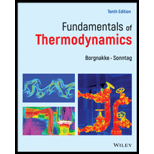
Fundamentals Of Thermodynamics
10th Edition
ISBN: 9781119494966
Author: Borgnakke, C. (claus), Sonntag, Richard Edwin, Author.
Publisher: Wiley,
expand_more
expand_more
format_list_bulleted
Question
error_outline
This textbook solution is under construction.
Students have asked these similar questions
Q2Air enters an insulated turbine at 50°C, and exits the turbine
at - 30°C, 100 kPa.The isentropic turbine efficiency is 70% and
T1=50C
V=20L/s
the inlet volumetric flow rate is 20 L/s. What is the turbine
Air
turbine
inlet pressure and the turbine power output?
T2=-30C.P2=100kpa
3. An adiabatic compressor takes argon from 100 kPa, 300 K to 2000 kPa. The compressor
efficiency is 80%.
(a) Find the outlet temperature (K) and the work (kJ/kg)
(b) Find the entropy generation (kJ/kg-K)
R-134a is throttled in a line flowing at 25°C, 750 kPa with negligible kinetic
energy to a pressure of 165 kPa. Find the exit temperature and the ratio of exit
pipe diameter to that of the inlet pipe (Dex/D;n) so the velocity stays constant.
Knowledge Booster
Learn more about
Need a deep-dive on the concept behind this application? Look no further. Learn more about this topic, mechanical-engineering and related others by exploring similar questions and additional content below.Similar questions
- The pressure and temperature entering the turbine is 1800kpaa and 380oC. The temperature leaving the turbine is 20kpa. The quality of steams entering the condenser is 90%. Find the turbine work in kJ/kg.arrow_forwardA steam turbine has an inlet of 2 kg/s water at 1000 kPa, 350°C and velocity of 15 m/s. The exit is at 100 kPa, x = 1 and very low velocity. Find the specific work and the power produced.arrow_forward5- Nitrogen gas flows into a convergent nozzle at 200 kPa, 400 K and very low velocity. It flows out of the nozzle at 100 kPa, 330 K. If the nozzle is insulated, find the exit velocity. a- 222 m/s b- 382 m/s c- 512 m/s d- 640 m/s AU-0 means that the process is isothermal?arrow_forward
- You have a nozzle with steam inlet at 350 deg C, 0.85 MPa and 12m/s. The stream exits at 0.4 MPa and 250 m/s. If stream 1 area is 750cm2, what is exit stream area and temperature?arrow_forward2. 1 kg/s steam enters the turbine at 2.5MPa and 500C while leaving at 10kPa with 89% quality. The pump exit condition is at 2.5 MPa and 50C. Find the turbine work output and heat added in the boiler in kW. (20 points)arrow_forwardAir enters an automotive supercharger at 100 kPa, 300 K and is compressed to 150 kPa. The efficiency is 70%. What is the required work input per kilogram of air? What is the exit temperature?arrow_forward
- A steam is expanded through a nozzle and the enthalphy drop per kg of steam from the initial pressure to the final pressure is 70 kJ. Neglecting the friction, find the velocity of discharge.arrow_forwardA one-stage compressor takes air at 100kpa and 25C with volume flow of 0.123m3/s and discharges to 800kpa. What is the heat rejected(kw) by the intercooler?arrow_forwardA single stage compressor is to compress 8.5m3/min from 98.56KPa to 985KPa. Polytropic constant is 1.3. How much is the savings in work in kW if this is converted in 2 stage compressor? complete solution tnx.arrow_forward
- one kg of air is compressed in a cylinder according to the law PV^1.3= constant. If intital temperature is 100°C amd compression ratio is 15, find the work done and change in entropy of air.arrow_forwardcan you write all steps ,and what you use (chart) be hurry pleasearrow_forwardI need the final answer only. A steam turbine operating at 5Mpa, 400C( h = 3195.7 KJ/kg) has an exhaust pressure of 100 Kpa( h = 2475 KJ/kg). It is made of two-row, velocity compounded stage at the vapor region of expansion with a blading efficiency of 74%.For a 5% rotational and leakage allowance, find the actual enthalpy of the exhaust.arrow_forward
arrow_back_ios
SEE MORE QUESTIONS
arrow_forward_ios
Recommended textbooks for you
 Elements Of ElectromagneticsMechanical EngineeringISBN:9780190698614Author:Sadiku, Matthew N. O.Publisher:Oxford University Press
Elements Of ElectromagneticsMechanical EngineeringISBN:9780190698614Author:Sadiku, Matthew N. O.Publisher:Oxford University Press Mechanics of Materials (10th Edition)Mechanical EngineeringISBN:9780134319650Author:Russell C. HibbelerPublisher:PEARSON
Mechanics of Materials (10th Edition)Mechanical EngineeringISBN:9780134319650Author:Russell C. HibbelerPublisher:PEARSON Thermodynamics: An Engineering ApproachMechanical EngineeringISBN:9781259822674Author:Yunus A. Cengel Dr., Michael A. BolesPublisher:McGraw-Hill Education
Thermodynamics: An Engineering ApproachMechanical EngineeringISBN:9781259822674Author:Yunus A. Cengel Dr., Michael A. BolesPublisher:McGraw-Hill Education Control Systems EngineeringMechanical EngineeringISBN:9781118170519Author:Norman S. NisePublisher:WILEY
Control Systems EngineeringMechanical EngineeringISBN:9781118170519Author:Norman S. NisePublisher:WILEY Mechanics of Materials (MindTap Course List)Mechanical EngineeringISBN:9781337093347Author:Barry J. Goodno, James M. GerePublisher:Cengage Learning
Mechanics of Materials (MindTap Course List)Mechanical EngineeringISBN:9781337093347Author:Barry J. Goodno, James M. GerePublisher:Cengage Learning Engineering Mechanics: StaticsMechanical EngineeringISBN:9781118807330Author:James L. Meriam, L. G. Kraige, J. N. BoltonPublisher:WILEY
Engineering Mechanics: StaticsMechanical EngineeringISBN:9781118807330Author:James L. Meriam, L. G. Kraige, J. N. BoltonPublisher:WILEY

Elements Of Electromagnetics
Mechanical Engineering
ISBN:9780190698614
Author:Sadiku, Matthew N. O.
Publisher:Oxford University Press

Mechanics of Materials (10th Edition)
Mechanical Engineering
ISBN:9780134319650
Author:Russell C. Hibbeler
Publisher:PEARSON

Thermodynamics: An Engineering Approach
Mechanical Engineering
ISBN:9781259822674
Author:Yunus A. Cengel Dr., Michael A. Boles
Publisher:McGraw-Hill Education

Control Systems Engineering
Mechanical Engineering
ISBN:9781118170519
Author:Norman S. Nise
Publisher:WILEY

Mechanics of Materials (MindTap Course List)
Mechanical Engineering
ISBN:9781337093347
Author:Barry J. Goodno, James M. Gere
Publisher:Cengage Learning

Engineering Mechanics: Statics
Mechanical Engineering
ISBN:9781118807330
Author:James L. Meriam, L. G. Kraige, J. N. Bolton
Publisher:WILEY
Power Plant Explained | Working Principles; Author: RealPars;https://www.youtube.com/watch?v=HGVDu1z5YQ8;License: Standard YouTube License, CC-BY